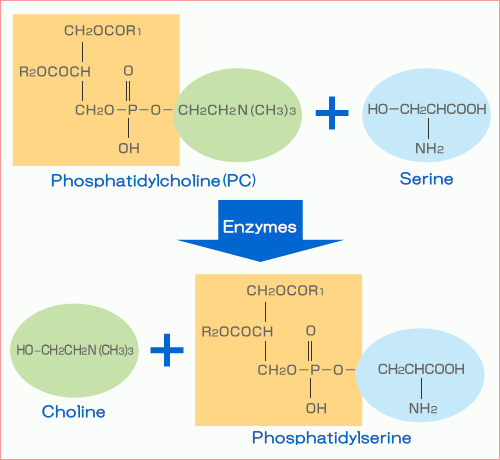
Manufactured by base exchange reaction using phosphatidylcholine (PC) contained in soybean lecithin as a raw material. The manufacturing method itself complies with Food Sanitation Act in Japan.

In the brain, PS occupies about 18% of the phospholipids in the brain cell membrane, and is located especially inside the cytoplasm.
Since phosphatidylserine (PS) is abundant in brain cell membranes, it has been suggested that it is related to brain function, and various studies and clinical trials have been conducted in the past.
Example of human phosphatidylserine (PS) clinical report
- Effective with Alzheimer's dementia 300 mg/day
- Effective with 300 mg/day of cerebral vasoconstriction dementia
- Memory loss with age 300mg/day is effective
- Effective with 300 mg/day of depression
- Epilepsy patient; seizure reduction
- Stress tolerance Cortisol reduction in exercise stress in adolescents
- Hormone secretion disorder Recovery of thyroid-stimulating hormone secretion rhythm
- Repair circadian rhythm abnormalities
- Normalization of thyroid hormone secretion rhythm
Proposed working hypothesis for clinical efficacy of phosphatidylserine (PS)
- Increase in brain acetylcholine (recovery of memory impairment model)
- Suppression of lipid peroxidation (reduction of cell free radical damage)
- Maintaining morphology of nerve cells (improving nerve transmission efficiency)
- Suppression of abnormal phosphorylation of tau protein (effect of improving dementia)
- Improvement of biological membrane function (improvement of exocytosis of neurotransmitters)
- Suppression of apoptosis
- Improvement of intracellular signal transduction system
- Improving hormone secretion
![]()

![]()

It is known that the activity of amylase enzyme in saliva is increased when external stress is applied.After ingesting phosphatidylserine (PS), amylase activity was suppressed predominantly compared to the initial value. In other words, it is considered that phosphatidylserine (PS) tolerance improved stress tolerance.
